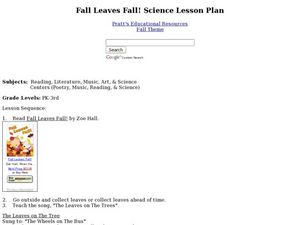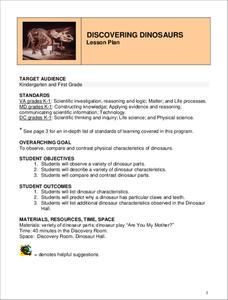Science Education Resource Center
Compare and Contrast deciduous and evergreen tree leaves to aid in tree identification
Boost observational skills and get to know the difference between deciduous, coniferous, and evergreen trees with a lesson that challenges scholars to compare, contrast, identify, sort, and draw their findings.
Curated OER
The Similarities and Differences of Setting
Sixth graders identify components of the setting in science fiction text. In this compare and contrast settings instructional activity, 6th graders read Only You Can Save Mankind and identify similarities and differences between...
Curated OER
Our Solar System - Comparing Planetary Travel Distances
NASA presents a mini-unit on distances in our solar system. It incorporates scientific concepts of gravity, mass, density, and payload while your aspiring astronauts also employ mathematics skills. They calculate speed, they determine...
Columbus City Schools
Sedimentary Rocks
Turn your class discussion of rock formation from ho-hum to holy hornfels! Junior geologists gain experience in identifying rock types and rock origins, with an emphasis in hypothesizing the environment needed to form certain...
Curated OER
Comparing and Contrasting a Desert Reptile and a Rainforest Mammal
First graders compare and contrast two different type of animals while also making predictions, observations, and asking provocative questioning. In this compare and contrast lesson, 1st graders acquire knowledge about why some animals...
Curated OER
Tree Comparison/Contrast Project
In this trees learning exercise, students put different kinds of trees into a chart and compare and contrast them. Students then answer percentage problems about the trees and short answer questions. Students complete 7 questions in all.
Curated OER
Lesson 6: Crowded Skies
This is a treasure-trove of multimedia resources to help your scholars analyze transportation methods. They discuss different forms of movement, utilizing several infographics to spur conversation deeper and get visual learners engaged....
Curated OER
Critical Thinking Strategies
Teach your readers to be critical thinkers. A strategy is outlined that can be used to compare and contrast entities. An example lists four states. The learner removes one state that "does not belong" in the list for some reason, and...
Curated OER
MUD-A Walk
Learners investigate their tracks to determine the number of footsteps it takes to travel the entire length of their bodies. Then they determine the taller of two children and the shorter of two children with their tracks. Students also...
Curated OER
A Yen for Maximum Residue Limits in Food
Future public health officials or agriculturists read an article and answer questions concerning the Japanese regulations for pesticide exposure. They compare the maximum residue limit for two, 4-D of Japan with other countries. This is...
Cold Spring Harbor Laboratory
Sex Cells Have One Set of Chromosomes; Body Cells Have Two
What's the difference between body cells and sex cells? Learners explore the question and the process of meiosis using an interactive lesson. An animation describes the discovery of meiosis and describes its phases for a detailed and...
University of Colorado
Looking Inside Planets
All of the gas giant's atmospheres consist of hydrogen and helium, the same gases that make up all stars. The third in a series of 22, the activity challenges pupils to make scale models of the interiors of planets in order to...
Curated OER
How to Make Invisible Ink
Students learn how to make two types of invisible ink. For this invisible ink lesson plan, students will make two types of invisible ink using common house hold items. They will then write a paper comparing and contrasting each type of ink.
Curated OER
Wild Horses of the Outer Banks
Students explore animal habitats. In this cross curriculum animal survival and writing lesson, students view a website about wild horses on Shackelford Island and discuss ways in which the horses have changed to this...
Curated OER
Flower Dissection
Students dissect three different flowers and compare and contrast them. In this flowers lesson plan, students learn about the flower anatomy and then dissect their own flowers.
Curated OER
Fall Leaves Fall
Students explore fall leaves. For this leaf lesson, students collect leaves to investigate. Students also measure, compare and contrast, draw and look at leaves through a magnifying glass. Students sing songs and use movement in this...
Curriculum Corner
Coniferous and Deciduous Trees
What are the differences between coniferous and deciduous trees? Supplement your tree lessons with a set of activities that has learners describing, naming, comparing, and reading about deciduous and coniferous trees. The activities are...
PHET
The Earth as a Magnet
Everyone loves playing with magnets and iron filings. Here, young scientists first observe and then participate in an activity demonstrating magnetic fields. After completing their observations, they apply this knowledge...
Curated OER
Comparing Fossils
Young scholars explore early hominid evolution as they analyze bones that share characteristics of both apes and humans. Students compare and contrast key skeletal differences between chimpanzees and humans. In groups, they sort and...
Curated OER
Discovering Dinosaurs
Students investigate the physical characteristics of dinosaurs. They participate in a puppet show, take a field trip to a dinosaur museum, and compare/contrast dinosaur characteristics at the museum.
Curated OER
Looking at Leaves Lesson 1
Fourth graders visit an outdoor area and compare/contrast two different leaves using Venn diagrams. They create tree leaf rubbings from their leaves and examine their vein structures or needle patterns.
Kenan Fellows
How Much Heat Can a Phase Change Produce?
Scholars learn about heat release in phase changes. They perform calculations as they compare and contrast a science fiction passage and a home heating application.
Curated OER
Reptiles and Amphibians
Introduce your class to various reptiles and amphibians. They will meet and identify a representative from each of the four major reptile families, then learn about and discuss reptile characteristics. Next, they will identify and...
Curated OER
Earthquakes: First Grade Lesson Plans and Activities
First graders explore how earthquakes release energy in a set of hands-on activities. During the pre-lab, they discover how energy from an earthquake releases waves through the earth using a water-filled cup and...























